IBHE director, University of Maryland president talk on diversity in higher ed
The Inclusive Excellence in Higher Education panel members featuring , from left, Executive Director of the Illinois Higher Education Board Ginger Ostro, the President of the University of Maryland at College Park Darryll Pines and Eastern University President David Glassman at Doudna Fine Arts Center Wednesday night.
April 6, 2022
Executive director of the Illinois Board of Higher Education shared plans to help diversify and promote inclusivity on campuses throughout Illinois on Wednesday night at Doudna Fine Arts Center.
Guests Ginger Ostro, the executive director of the Illinois Board of Higher Education (IBHE), and Darryll Pines, president of the University of Maryland, spoke to the campus community about increasing inclusive excellence in higher education.
This presentation provided a discussion about how Ostro is moving forward to increase diversity rates in Illinois and how Pines helped improve diversity at the University of Maryland when he became president on July 1, 2020.
Part of Ostro’s presentation shared the IBHE’s recent state agency Thriving Illinois, which hadn’t been updated in over a decade.
“We had planned to launch that strategic planning process right in March,” Ostro said. “And of course, the pandemic hit and everything was shut down, so we put the strategic planning process on hold. Then the George Floyd murder happened over the summer, and we knew that our strategic plan was going to focus on equity, and we certainly have to act now. We’re going to do it virtually, but we’re going to start now because this is the moment in time to really get thinking about what is the future of higher education in the state. And why is it? Why does it matter? And so our process was incredibly broad and incredibly inclusive.”
Within the plan Thriving Illinois, there were three key parts of the strategic plan.
“First, closing equity gaps for students who’ve been left behind,” Ostra said. “And we’re very specific, there’s a broad definition of who we’re targeting, but specifically we’re talking about Black students, Latinx, low income students, working adults and bright students. Now the strategies were designed, and as we have the groups recognize and address as much broader groups of students who have been historically underserved, but this is our particular focus.”
The second stage of the plan is a focus on sustainability.
“Building strong financial futures for individuals and for institutions,” Ostro said. “And you’ve been well you’ll see in a moment that it’s about affordability, but we know we have to support our institutions, as well as support our students that we’re going to have a system that’s going to be sustainable.”
The final focus of the Thriving Illinois strategic plan is a focus on growth.
“We know we need to prepare the talent that the state we’re the workforce, the talent the state needs for business and employers and that higher education is such an important part in addition to that, to generating innovation and economic growth for the state,” Ostro said.
Pines became president shortly after the beginning of the COVID-19 pandemic and the social justice movement, Black Lives Matter, following George Floyd’s death.
This led to Pines coming into his new role with two main goals for the University of Maryland.
“I expect for academic research and service missions that we be excellent in everything that we do,” Pines said. “Then number two, that was a high mark for me, to create a multicultural inclusive community where every environment, every person feels that they belong.”
Madelyn Kidd can be reached at 581-2812 or at mekidd@eiu.edu.





































































